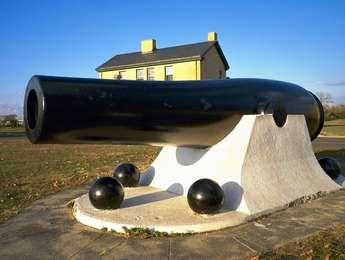Last updated: March 9, 2021
Place
20 Inch Rodman Gun

Historical/Interpretive Information/Exhibits, Parking - Auto
The 20-inch Rodman Gun is the largest muzzle-loading, smoothbore cannon ever made. It is located in Fort Hancock across from the Sandy Hook Chapel.
Lieutenant Thomas Jackson Rodman
Lieutenant Rodman graduated from the military academy in 1841 and was assigned to the Ordnance Department at Allegheny Arsenal in Pittsburgh. When Lieutenant Rodman heard that a large new cannon blew up while being fired on board the U.S. Navy warship USS Princeton in 1844, he started to think about how a big cannon could be made that was safe enough to fire. Lieutenant Rodman theorized that a cannon cooled from the inside out would make a super strong gun metal.
The Wet Chill
Rodman believed that internal cooling would cause the outer molten metal to compress against the bore and create enough tension to resist the pressure of large powder charges. Basically, he brought back the hollow casting process, but, instead of a solid core, he used a hollow tube. Water circulating through the tube cooled the bore while coals were piled against the mold to keep the outer surface hot. Lieutenant Rodman's manufacturing method, now known as the "wet chill process", forced the impurities outward while the outer metal shrank against the hardened interior.
Persistence
The first 15-inch Rodman gun was cast on December 23,1859. During the gun trials, 509 proofing rounds were fired. Since there were no accidents or misfires during the testing, the government saw fit to order these large guns in November 1861. During the Civil War, the Rodman guns were the largest in the U.S. arsenal. Two 20-inch guns were purchased, but the 15-inch gun, along with the 200 pounder (12-inch) muzzle loading Parrot Rifle, became the main seacoast armament.
No. 2 Rodman Gun
The second 20-inch gun was made in 1869, and, as far as anyone knows, it was never fired. The No. 2 Rodman gun was exhibited at the 1876 Philadelphia Exposition that celebrated the 100th birthday of the United States. At some point after the exposition ended, the No.2 gun ended up at the U.S. Army Sandy Hook Proving Ground, where it sat in storage for many years. In 1903, the commander of Fort Hancock wrote the Army's Chief of Ordnance, requesting that the gun be transferred from the Ordnance Department over to Fort Hancock, operated by the Army's Coast Artillery Corps. The gun was transferred to Fort Hancock where it was displayed "as a monument to the old class of guns," as the Fort Hancock commander referred to it. The move probably saved this rare cannon from being scrapped.
